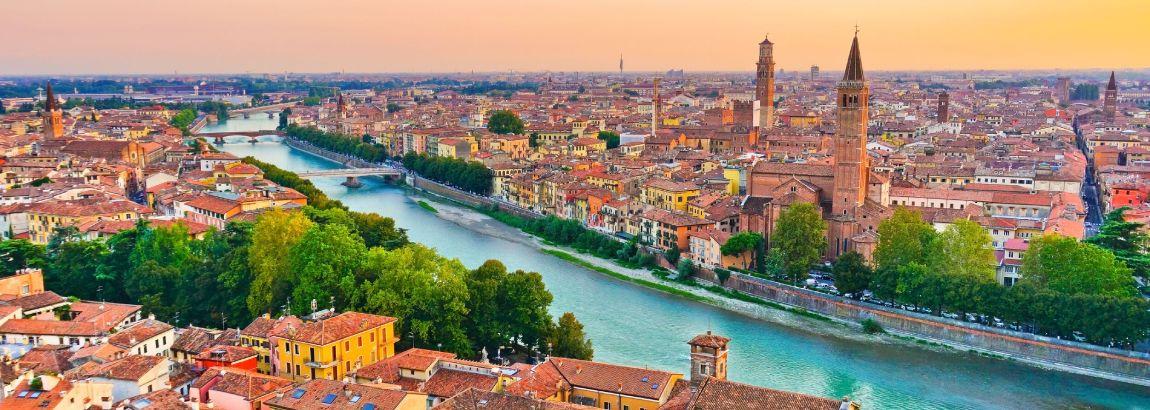
| City - Airport | Departure: | ||
| Iasi | Chisinau | ||
| to Verona (VRN) | IAS → VRN | RMO → VRN | |
| - Verona Villafranca (VRN) | IAS → VRN | RMO → VRN | |
Built in the XIV century, the building with a small balcony overlooking the courtyard is called "Juliet's House". Also in the city there is a Roman amphitheater of the 1st century, Arena di Verona. Now it hosts various concerts and major opera performances.
the name by which the antique Roman amphitheater, built in Verona around 30 AD, is known. Located in the main square of the city - Piazza Bra. The Arena di Verona is a world famous concert venue. The amphitheater in Verona is the fourth largest among similar Roman buildings in Italy. One of the best preserved structures of this type. In 2000, as part of other historical monuments in Verona, the amphitheater was included in the list of World Heritage Sites.
house in Verona, built in the XIII century. It is a popular tourist destination, identified with the legendary home of the heroine of the play by William Shakespeare "Romeo and Juliet".
Roman arched bridge over the Adige river in the Italian city of Verona. The bridge was built around 89 BC. e. Initially it was called the Marmoreus Bridge, and later, after the reconstruction, it received its current name. A watchtower has been erected on one side of the bridge. The bridge is 120 meters long. In 1945, when the German army retreated from the city, it was completely destroyed, like the rest of the city's bridges. In 1957, the stone bridge was rebuilt using original fragments raised from the bottom of the river.
Catholic cathedral in the city of Verona, seat of the bishop's chair of the city. The construction of the temple in the Romanesque style began in the first half of the 12th century, and the consecration took place in 1187. In the middle of the 15th century, it was built on and expanded, as a result of which it acquired late Gothic features. The entrance portal with a portico on twisted columns, resting on winged griffins, remained from the original Romanesque appearance.
square in the city of Verona, located on the site of the ancient forum. The rectangular square is framed by buildings from different eras: Domus Mercatorum - a building in the Gothic style, which served as the seat of professional corporations in the Middle Ages.
Romanesque basilica in Verona, built over the burial place of the first bishop of Verona - Zinon of Verona.
gothic basilica in the city of Verona. The largest of the city's churches. It was erected in honor of the Christian holy great martyr Anastasia the Patterner. Earlier on this site there was an older church dedicated to the same saint. The basilica was designed by two Dominican monks Fra Benvenuto da Bologna and Fra Nicola da Imola. Construction began in 1290 and continued until 1481.
museum in the city of Verona. Founded in 1923, the exhibitions are housed in the abolished monastery of San Gerolamo next to the Roman Theater, which was acquired by the municipality. The collection of the museum was formed mainly through donations of exhibits from private collections. The exposition includes ancient Roman mosaics, antique sculpture, ceramics, bronze figurines, Roman glass vessels. The museum includes the monastery church of St. Jerome with frescoes by Caroto, a triptych by a Verona master of the 15th century and an early Christian statue of the Good Shepherd.
the city gate in Verona, built by the architect Sanmicheli in 1535-1540 during the construction of the city's defensive fortifications. In 1854 Porta Nuova was rebuilt by the Austrians, who received the city following the Vienna Congress. They added side chapels to the gates, and tufted the gates. As a result of the reconstruction, only the central part has retained the original appearance of the 16th century. The cornerstone of the central arch of the gate is adorned with the head of Jupiter. The street of the same name begins from Porta Nuova, which leads to the main square of the city - Piazza Bra.
a monument of ancient Roman architecture in the city of Verona. Porta Borsari was built in the 1st century as a military outpost in the south of the city. Currently, the building is the façade of a building that has not survived, which served as the garrison's barracks, guarding the main entrance to the city. The structure is made in three tiers: on the first there are two arched openings that served as entrance gates, the two upper tiers each contain six arched openings, framed by semi-columns. On the pediment of the lower tier, an inscription from 245 has been preserved, containing the ancient Roman name of the city: COLONIA VERONA AUGUSTA.
Airports: